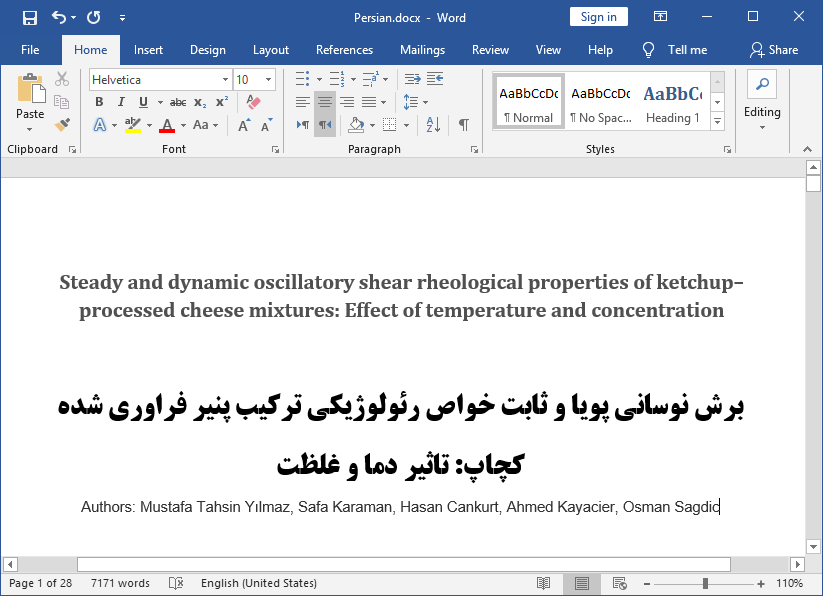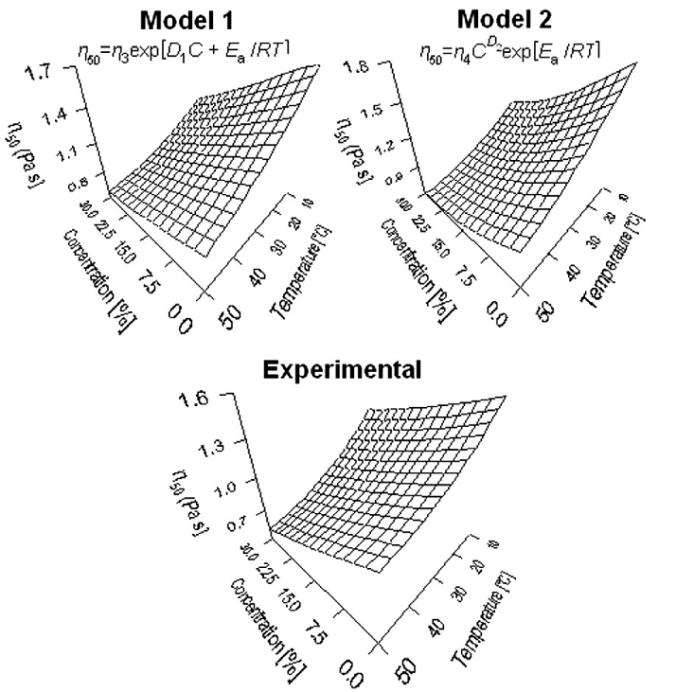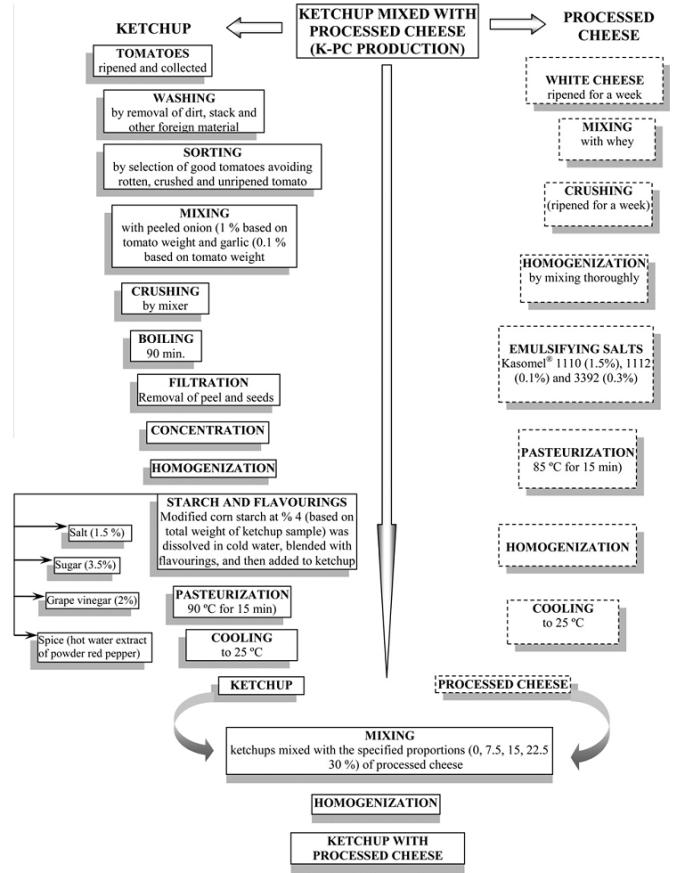اثر دما و غلظت در برش نوسانی پویا و ثابت خواص رئولوژیکی مخلوط پنیر فراوری شده کچاپ


27,600 تومانشناسه فایل: 8540
- حجم فایل ورد: 1.3MB حجم پیدیاف: 746.5KB
- فرمت: فایل Word قابل ویرایش و پرینت (DOCx)
- تعداد صفحات فارسی: 28 انگلیسی: 14
- دانشگاه:
- Food Technology Department, Safiye Cikrikcioglu Vocational College, Erciyes University, 38039 Kayseri, Turkey
- Food Engineering Department, Engineering Faculty, Erciyes University, 38039 Kayseri, Turkey
- ژورنال: Journal of Food Engineering (1)
چکیده
خواص برشی ثابت و پویای پنیر سس گوجه فرنگی فرآوری شده (K-PC) در دماهای مختلف (10-50C) و غلظت (0-30%) PC مورد بررسی قرار گرفت. مخلوط K-PC یک رفتار برشی رقیق با تنش تسلیم کمی از خود نشان داد. ضریب پایداری (K) و ویسکوزیته ظاهری (η50) با افزایش دما و غلظت کاهش یافت. مخلوط رابطه ی دمای آرنیوسی را دنبال کرد که نشان داد اندازه ی انرژی فعال سازی (Ea) در طیف 17.16-8.88 kj.mol-1 بود. ضرایب ذخیره سازی (G′)، اتلاف (G′′) و مدول مختلط (G∗) با افزایش در فرکانس افزایش یافت درحالیکه ویسکوزیته ی مختلط (η*) کاهش یافت. مخلوط K-PC در غلظت های 0-15% خاصیت ژل مانند ضعیفی نشان داد. افزایش در غلظت PC منجر به کاهش 15% غلظت G′ در G′′ و η* شد که مقدار کمی بین 0% و 30% غلظت را نشان داد. قانون Cox-Merz برای مخلوط K-PC قابل اجرا نبود.
مقدمه مقاله
سس گوجه فرنگی یکی از مهم ترین محصولات گوجه فرنگی است که اساسا یا از عصاره ی گوجه فرنگی سرد و گرم و یا مستقیما از کنسانتره، پوره و رب گوجه فرنگی تولید می شود (Sahin و Ozdemir، 2004). اگرچه سس گوجه فرنگی در سراسر جهان شناخته شده است، اما اطلاعات در مورد این محصول در ادبیات بسیار محدود است (Sharoba et al, 2005). سس گوجه فرنگی یک مایع مستقل از زمان، نیمه جامد غیر نیوتنی است که تنش تسلیم معینی دارد (Sharoba et al, 2005). بر مبنای داده های برش پویا، گزارش شد که قانون Cox-Merz برای نمونه های سس گوجه فرنگی تجاری قابل اجرا نبوده است (Bistany و Kokini، 1983) که خواصی مشابه ژل ضعیف را از خود نشان داد (Rao و Cooley، 1992).
پنیر فرآوری شده یک محصول لبنی است که با ترکیب پنیرهای طبیعی با نمک امولسیون و آب تحت تاثیر دما و تحریک بدست می آید. پس از هموژنیزه کردن ترکیب مذاب، محصول بسته بندی و سرد می شود. در سال های اخیر، پنیرهای فرآوری شده ی کاهنده یا کم چرب وارد بازار شده اند (Drake و Swanson 1995).
پروتئین های شیر معمولا به عنوان مواد غذایی در فرمولاسیون محصولات غذایی متنوع مورد استفاده قرار می گیرند که این اساسا به دلیل ویژگی های عملکردی منحصربفرد شان مانند امولسیون، ژل مانند بودن، ضخامت، کف کردن و ترکیب آبی است (Kinsella و Whitehead 1989). علاوه بر خواص عملکردی، پروتئین های شیر نیز به دلیل ارزش غذایی بالایشان و وضعیت GRAS مورد استفاده قرار می گیرند (Bryant و McClements، 1998، Harper 2000، Hudson et al، 2000). آن ها در سطوح بهینه به منظور بهبود بافت،طعم، رنگ مواد غذایی و همینطور به منظور افزایش میزان پروتئین با ارزش بیولوژیکی بالا مورد استفاده قرار می گیرند (kilara, 1994). به خاطر دلایل فوق، سس گوجه فرنگی می تواند با منابعی حاوی پروتئین لبنیات مانند پنیر فرآوری شده به منظور بدست آوردن مواد مغذی اضافه و غنی شوند.
نشاسته معمولا به عنوان عامل غلظت مورد استفاده قرار می گیرد (Sidha et al, 1997; Sirvastava, 1982). به دلیل اینکه نشاسته خواص عملکردی ای مانند شکل گیری شبکه ی ژل پلیمرهای زیستی معمولی (Mohammed et al, 1998) و تغییر خواص رئولوژیکی مانند تیکسوتروپی و رئوپکتیک دارد به فرمولاسیون سس گوجه فرنگی اضافه می شوند (Sharoba et al, 2005). بنابراین،فرض می شود نشاسته نقش چندگانه ای در سیستم نمک وفلفل ایفا کند، و ویسکوزیته بودن را در نقاط کلیدی فرآوری فراهم کند و همینطور برای دست آوردن تعلیق سازگار نیز مورد استفاده قرار می گیرد (Alam et al, 2009). به این دلایل، نشاسته در صنعت به سس گوجه فرنگی اضافه می شود تا کیفیت خوبی از محصول نهایی بدست آید (Hooverو Ratnayake 2000).
نشاسته و پروتئین شیر در مواد غذایی لبنی بسیاری مانند کاستارد ها (Doublier و Durand 2008)، ماست (Keogh و O’Kennedy 1998) و پنیرهای فرآوری شده (Mounsey و Oriordan 2008a) وجود دارد. از دیدگاه علمی، گزارش شده است که پنیر فرآوری شده یک سیستم مدل ایده آل برای بررسی فعل و انفعالات اجزای اصلی موادغذایی-پروتئین/چربی/پلی ساکارید (نشاسته) و آب ایجاد می کند( Mounsey و Oriordan 2008b). مطالعات در مورد تعامل بین نشاسته و پروتئین فرآورده های لبنی در مقایسه با ترکیبات پروتئین شیر و دیگر بیوپلیمرها علیرغم اهمیت صنعتی و بررسی های متعدد پروتئین شیر و نشاسته به طور مجزا بسیار محدود می باشد (Noisuwan et al, 2009). بر مبنای این حقیقت، ترکیب پنیر فرآورده شده ی سس گوجه فرنگی (K-PC) می تواند مثالی از چنین تعامل باشد چراکه مورد پیشینه شامل نشاسته و مورد بعدی منبع پروتئین شیر و چربی است.
ویسکوزیته که معمولا به عنوان یک مشخصه ی فیزیکی مهم غذاهای مایع یا نیمه مایع در نظر گرفته می شود، به کیفیت محصولات مرتبط است. بنابراین، اطلاعات رفتار جریان ممکن است در کنترل کیفیت، محاسبات انرژی ورودی، طراحی فرایند انتخاب فرایند تجهیزات مانند مبدل های حرارتی و پمپ ها مورد استفاده قرار گیرد. بعلاوه، خواص رئولوژیکی مواد غذایی مایع کیفیت حسی و در نتیجه علایق مصرف کننده را تحت تاثیر قرار می دهد. با این وجود، این خواص به طور گسترده توسط ترکیبات شیمیایی، مقدار PH، شرایط فرآوری و برخی مواد افزودنی تحت تاثیر قرار می گیرد (Bowland و Foegeding، 2001؛ Marchesseau و Cuq، 1995؛ Piska و Sttina، 2004(. خواص ویسکوالاستیک پراکندگی ماکرومولکولی می تواند با استفاده از آزمون رئولوژیک برش نوسانی پویا تعیین شود (Rao, 1999). در آزمون پویا، چرخه فشار سینوسی برای تعیین مدول ذخیره سازی، مدول های اتلاف ، مدول های پیچیده و ویسکوزیته ی مختلط مورد استفاده قرار می گیرد. مطالعات پیشین حضور ارتباطی بین برش ثابت و خواص برشی پویا از پراکندگی ماکرومولکولی را نشان داد (Chun و Yoo، 2004). قانون انطباق Cox-Merz که برش ویسکوزیته ی پویا مختلط را به عنوان تابع میزان برش در نظر میگیرد، برای چندین پراکندگی ماکرومولکولی به صورت تجربی تایید شد (Chun و Yoo، 2004)، از سوی دیگر، Da Silva و Rao (1992) گزارش کرده اند که قانون Cox-Merz برای پراکندگی ماکرومولکولی با درهم تنیدگی بالا یا تراکم معتبر نبوده است.
تا کنون هیچ تلاشی برای مطالعه ی خواص رئولوژیکی ترکیبات K-PC به عنوان تابع دما و غلظت صورت نگرفته است. بویژه، هیچ اطلاعاتی در مورد خواص رئولوژیکی ترکیبات K-PC تحت دو برش پویا و ثابت موجود نیست. بنابراین، این مطالعه برای تعیین رفتار رئولوژیکی ترکیبات پنیر فرآوری شده ی سس گوجه فرنگی در برش ثابت و پویا انجام شده است که تحت تاثیر دماهای (10-50C) و طیف غلظت متفاوت (0-30%) قرار گرفته است
ABSTRACT Steady and dynamic oscillatory shear rheological properties of ketchup–processed cheese mixtures: Effect of temperature and concentration
The steady and dynamic shear properties of ketchup–processed cheese (K–PC) mixtures were investigated at different temperatures (10–50 °C) and PC concentrations (0–30%). The K–PC mixtures showed a shear-thinning behavior with low magnitudes of yield stress. The consistency coefficient (K) and apparent viscosity (η50) decreased with increase in temperature and concentration. The mixtures followed the Arrhenius temperature relationship, indicating that the magnitudes of activation energies (Ea) were in the range of 8.83–17.16 kJ mol−1. Storage (G′), loss (G′′) and complex (G∗) modulus increased with increase in frequency while complex viscosity (η∗) decreased. The K–PC mixtures at concentrations of 0–15% exhibited weak gel-like behavior. Increase in the PC concentration resulted in a decrease in G∗, G′, G′′ and η∗ up to the 15% of PC concentration, showing a plateau value between 0% and 30% concentrations. Cox–Merz rule was not applicable to K–PC mixtures.
Introduction
Ketchup, one of the most important tomato products, is produced basically from either cold or hot extracted tomatoes; or directly from concentrates, purees and tomato paste (Sahin and Ozdemir, 2004). Although ketchup is known worldwide; information on this product is limited in the literature (Sharoba et al., 2005). Ketchup is time-independent, semi-solid non-Newtonian fluid having a definite yield stress (Sharoba et al., 2005). Based on dynamic shear data, it was also reported that the Cox–Merz rule was not applicable for commercial tomato ketchup samples (Bistany and Kokini, 1983), exhibiting properties similar to weak gels (Rao and Cooley, 1992).
Processed cheese is a dairy product obtained by mixing natural cheeses with emulsifying salts and water under the influence of heat and agitation. After homogenization of molten blend, the product is packed and cooled. In recent years, reduced- or lowfat processed cheeses have entered the marketplace (Drake and Swanson, 1995).
Milk proteins are commonly used as food ingredients in the formulation of various food products due to their unique functional characteristics like emulsifying, gelling, thickening, foaming and water binding (Kinsella and Whitehead, 1989). In addition to functional properties, milk proteins are also utilized because of their high nutritive value and GRAS status (Bryant and McClements, 1998; Harper, 2000; Hudson et al., 2000). They are used at optimal levels to improve texture, flavor and color of foods as well as to increase the amount of proteins with high biological value (Kilara, 1994). Because of the aforementioned reasons, ketchup could be supplemented or enriched with the sources containing dairy proteins like processed cheese to obtain a nutritionally enriched product.
Starch is commonly used as thickening agent (Sidhu et al., 1997; Srivastava, 1982). It is added to ketchup formulations because it has some functional properties such as formation of typical biopolymer gel network (Mohammed et al., 1998) and alteration of rheological properties such as thixotropic and rheopectic flow properties (Sharoba et al., 2005). Therefore, starch is assumed to play multifunctional role in a condiment system, providing viscosity at key processing points, as well as helping to maintain consistent suspension (Alam et al., 2009). For these reasons, starch is added to tomato ketchup in industry to achieve good quality of the final product (Hoover and Ratnayake, 2002).
Starch and milk proteins are present together in various dairybased foods including custards (Doublier and Durand, 2008), yoghurts (Keogh and O’Kennedy, 1998) and processed cheeses (Mounsey and Oriordan, 2008a). From a scientific perspective, processed cheese is reported to provide an ideal model system to examine the interactions of the major food components – protein/ fat/polysaccharides (starch) and water (Mounsey and Oriordan, 2008b). Studies about the interactions between starch and dairy proteins are limited in the literature compared to those of mixtures of milk proteins and other biopolymers in spite of the industrial importance and extensive investigation of starch and milk proteins separately (Noisuwan et al., 2009). Based on the fact, ketchup–processed cheese (K–PC) mixture could be an example of such interactions as the former includes starch and the later is a source of casein (milk protein) and fat.
Viscosity, usually considered as an important physical characteristic of fluid or semifluid foods is related to the quality of products. Therefore, the flow behavior information may be useful in quality control, energy input calculations, process design and selection of process equipment, such as heat exchangers and pumps. In addition, the rheological properties of fluid foods affect the sensory quality and consequently consumer preference. However, these properties are widely influenced by chemical composition, pH value, processing conditions and also by some added ingredients (Bowland and Foegeding, 2001; Marchesseau and Cuq, 1995; Piska and Šttina, 2004). The viscoelastic properties of macromolecular dispersions can be determined by using dynamic oscillatory shear rheological tests (Rao, 1999). In a dynamic test, sinusoidal strain cycle is utilized for the determination of the storage modulus (G0), loss modulus (G00), complex modulus (G*) and complex viscosity (g*). Previous studies indicate the presence of a correlation between steady shear and dynamic shear properties of macromolecular dispersions (Chun and Yoo, 2004). The Cox–Merz superposition rule which relates the complex dynamic shear viscosity (g*) as a function of angular frequency (x) to the steady shear flow viscosity (g) as a function of shear rate (c_) has been experimentally confirmed for several macromolecular dispersions (Chun and Yoo, 2004), on the other hand, Da Silva and Rao (1992) reported that Cox–Merz rule was not valid for macromolecular dispersions with either hyperentanglements or aggregates.
No attempt has been made so far to study rheological properties of K–PC mixtures as a function of temperature and concentration. In particular, no information is available on the rheological properties of K–PC mixtures under both steady and dynamic shear. Therefore, this study was undertaken to determine the rheological behaviors of ketchup–processed cheese mixtures in steady and dynamic shear as affected by different temperatures (10–50 C), concentration ranges (0–30%).












- مقاله درمورد اثر دما و غلظت در برش نوسانی پویا و ثابت خواص رئولوژیکی مخلوط پنیر فراوری شده کچاپ
- پروژه دانشجویی اثر دما و غلظت در برش نوسانی پویا و ثابت خواص رئولوژیکی مخلوط پنیر فراوری شده کچاپ
- اثر دما و غلظت در خواص رئولوژیکی مخلوط پنیر کچاپ
- پایان نامه در مورد اثر دما و غلظت در برش نوسانی پویا و ثابت خواص رئولوژیکی مخلوط پنیر فراوری شده کچاپ
- تحقیق درباره اثر دما و غلظت در برش نوسانی پویا و ثابت خواص رئولوژیکی مخلوط پنیر فراوری شده کچاپ
- مقاله دانشجویی اثر دما و غلظت در برش نوسانی پویا و ثابت خواص رئولوژیکی مخلوط پنیر فراوری شده کچاپ
- اثر دما و غلظت در برش نوسانی پویا و ثابت خواص رئولوژیکی مخلوط پنیر فراوری شده کچاپ در قالب پاياننامه
- پروپوزال در مورد اثر دما و غلظت در برش نوسانی پویا و ثابت خواص رئولوژیکی مخلوط پنیر فراوری شده کچاپ
- گزارش سمینار در مورد اثر دما و غلظت در برش نوسانی پویا و ثابت خواص رئولوژیکی مخلوط پنیر فراوری شده کچاپ
- گزارش کارورزی درباره اثر دما و غلظت در برش نوسانی پویا و ثابت خواص رئولوژیکی مخلوط پنیر فراوری شده کچاپ
